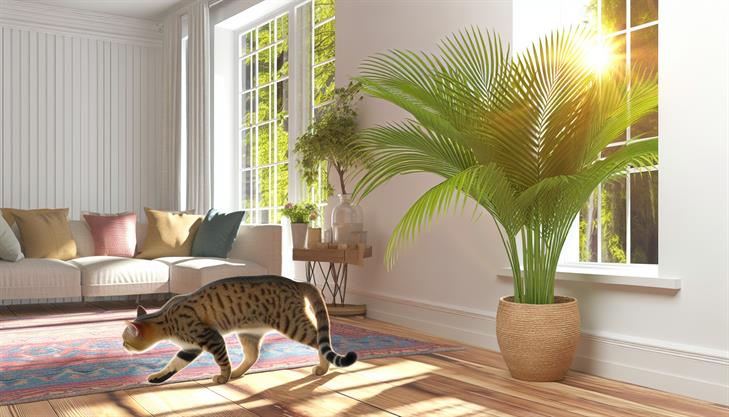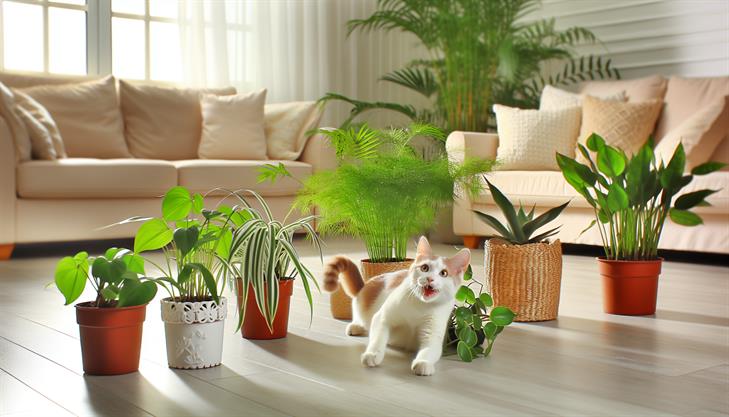Every cat owner knows the joy of watching their feline friend explore the world with curiosity and grace. But with that freedom comes the responsibility of ensuring their environment is safe, particularly when it comes to houseplants. Among the lush greenery that transforms your home into a vibrant oasis, the areca palm stands out with its feathery fronds and exotic appeal. But as captivating as it may be, a crucial question looms for cat lovers: Is the areca palm toxic to cats? Understanding the relationship between your pets and your plants is not just a matter of curiosity—it’s paramount to their well-being. This guide delves into the potential risks and safeguards associated with the areca palm, equipping you with the knowledge to keep your feline companions both happy and healthy. As you navigate the world of pet-friendly plants, let us help you ensure that your home remains a safe haven for your beloved kitty.
Understanding Areca Palm and Its Popularity in Homes
The Areca Palm (Dypsis lutescens), also known as the Butterfly Palm or Golden Cane Palm, is a popular choice for indoor plant enthusiasts due to its lush fronds and air-purifying qualities. However, a common concern for pet owners looking to introduce this plant into their homes is whether the Areca Palm is toxic to cats.
Firstly, it’s important to clarify that the Areca Palm is non-toxic to cats. According to the American Society for the Prevention of Cruelty to Animals (ASPCA), this plant is completely safe for both cats and dogs. This makes it an excellent choice for households with pets, as pet owners can enjoy the aesthetic and health benefits without worrying about potential harm to their furry friends.
When introducing an Areca Palm into your home, there are a few steps you can follow to ensure both your plant and your cat coexist happily:
-
Proper Placement: Although Areca Palms are non-toxic, curious cats may still attempt to nibble on the fronds. To prevent unnecessary mess or damage to the plant, place the palm in a location that is not easily accessible to your cat, such as a plant stand or a shelf that’s out of reach.
-
Training and Deterrents: If your cat shows too much interest in the plant, provide alternative entertainment or distractions. Cat toys and scratching posts can redirect their curiosity. Using a pet-safe deterrent spray around the base of the plant can also help keep pets at a distance.
-
Regular Maintenance: Maintain the health of your Areca Palm with regular watering, adequate light, and occasional pruning. A healthy plant is less likely to lose fronds or soil, which might otherwise attract the attention of a playful cat.
-
Monitor Interaction: Keep an eye on how your cat interacts with the plant. While the Areca Palm is safe, excessive curiosity could still lead to minor digestive disturbances if large quantities of the non-toxic foliage are ingested.
-
Alternatives and Additions: If you’re building a pet-friendly plant collection, consider other non-toxic options like the Boston Fern or Spider Plant. Having a variety of safe plants can enhance your living space without compromising pet safety.
In summary, the Areca Palm is a cat-friendly houseplant that poses no toxic threat to your feline companions. By following these setup tips and regularly observing your pet’s behavior, you can create a harmonious environment where both your plants and pets thrive. Whether you’re attracted to its graceful leaves or its ability to improve indoor air quality, the Areca Palm remains a reliable and stylish choice for pet owners.
Areca Palm’s Effects on Cats: What You Need to Know
Areca palms, often recognized for their lush green fronds and tropical aesthetic, are a popular choice for indoor and outdoor decor. However, when it comes to cat owners, a common question arises: is the areca palm toxic to cats?
Understanding Areca Palms and Cats
The good news for feline lovers is that areca palms (Dypsis lutescens), also known as butterfly palms, golden palms, or cane palms, are non-toxic to cats. This means that if your curious cat decides to nibble on a leaf, you won’t have to worry about toxicosis. However, it’s essential to understand that while the plant is non-toxic, consumption in large amounts may still lead to minor digestive upset, such as vomiting or diarrhea.
Signs to Watch For
Even with non-toxic plants, cats can experience mild symptoms if they consume significant quantities. Symptoms to monitor include:
- Vomiting
- Diarrhea
- Lack of appetite
If these symptoms occur, it’s advisable to monitor your cat closely. If they persist or worsen, consulting a veterinarian is recommended.
Tips for Keeping Cats Safe with Areca Palms
-
Positioning: Place your areca palm in areas that are least accessible to your cats. Consider using plant stands or placing pots on higher surfaces to deter inquisitive paws.
-
Training: Use deterrents to train your cat to stay away from the plant. Cat-safe spray deterrents or double-sided tape around the pot can effectively keep cats at bay without causing harm.
-
Provide Alternatives: Cats often chew on plants out of curiosity or boredom. Providing cat grass or other cat-friendly plants can satisfy their chewing instincts safely.
-
Regular Monitoring: Keep an eye on your areca palm for any signs of overindulgence by your pet. This includes checking for bite marks or missing leaves.
Additional Advice
While areca palms are safe, homes with pets should always approach new plant introductions with caution. A quick check of the ASPCA’s list of toxic and non-toxic plants can confirm whether a species is safe. Additionally, for homes with multiple types of plants, remember that each species can have varying levels of toxicity. Always ensure that all your indoor greenery is non-toxic to your furry friends.
By following these guidelines, you can enjoy the benefits of areca palms without compromising the wellbeing of your cat. Keeping your living space both stylish and safe is entirely possible with a little foresight and preparation.
Tips for Ensuring Your Cat’s Safety Around Areca Palms
When it comes to ensuring the safety of your feline friends around houseplants, it’s important to know which plants may pose a risk. If you’re wondering, "Is areca palm toxic to cats?" the good news is that areca palms (Dypsis lutescens) are not toxic to cats. This makes them a popular choice among pet owners looking to enhance their home with greenery without endangering their pets.
Understanding Areca Palms
Areca palms, also known as butterfly palms or yellow palms, are known for their graceful, feathery fronds and tropical appeal. They are considered non-toxic to cats, dogs, and humans, according to the American Society for the Prevention of Cruelty to Animals (ASPCA). This non-toxic nature places areca palms among the safer options for indoor plants in pet-friendly homes.
Tips for Cat Safety Around Areca Palms
Even though areca palms are non-toxic, there are a few considerations to ensure your cat’s safety and the well-being of your plant:
-
Supervise Initial Interactions:
- When introducing a new areca palm to your home, observe your cat’s behavior around the plant. Cats are naturally curious and may want to nibble or paw at the fronds.
-
Place Strategically:
- Position your areca palm in a location that’s not easily accessible to your cat. Consider elevated plant stands or shelves to keep them out of reach while still benefiting from the plant’s ornamental appeal.
-
Discourage Chewing:
- While the plant isn’t toxic, frequent chewing can cause gastrointestinal upset in cats or damage the plant. To discourage this behavior, consider using "cat-safe" deterrent sprays available at pet stores, or provide alternative plants, such as cat grass, for safe chewing.
-
Create a Dedicated Play Zone:
- Ensure your indoor environment includes plenty of toys and scratching posts, reducing the chances of your feline friend using the plant as a toy.
-
Regular Plant Maintenance:
- Keep the palm healthy by ensuring it has proper light, water, and soil conditions. A well-maintained plant is less likely to drop leaves, reducing the potential mess and attraction for your cat.
-
Monitor Plant Health:
- If you notice your cat showing signs of distress, like vomiting or lethargy, it could be unrelated to the non-toxic areca palm but warrant checking other possible ingestions around your home.
By following these guidelines, you can keep your home both aesthetically pleasing and safe for your cats. The presence of an areca palm should not be a cause for concern but rather an opportunity to enrich your living space naturally. Remember, creating an environment where plants and pets peacefully coexist requires some planning, observation, and care.
Alternative Cat-Friendly Plants for Your Home
If you’re a cat owner looking to enhance your home with greenery, you’ll want to ensure the plants you choose are safe for your feline friends. A common question is whether the areca palm is toxic to cats. The good news is that the areca palm (often referred to as the "butterfly palm" or "feather palm") is not toxic to cats. This is a fantastic choice if you’re seeking a pet-friendly plant to beautify your indoor space.
Understanding Areca Palm’s Non-Toxicity to Cats
The areca palm is renowned for its lush and feathery fronds, making it a popular choice for indoor décor. Unlike many other houseplants, it poses no risk to your cats. This means if your curious kitty decides to nibble on the leaves, there’s no danger of toxicity.
Tips for Introducing Areca Palms to Your Cat-Friendly Home
-
Selecting a Healthy Plant: When purchasing an areca palm, choose a vibrant and healthy specimen. Look for one with bright green fronds and avoid any with brown spots or drooping leaves, as these could indicate disease or poor health.
-
Placement: Cats are natural explorers, so place your areca palm in an area that suits both its growth needs and your pet’s behavior. These palms thrive in bright, indirect sunlight. Consider a corner or beside a window where it won’t be directly in the sun.
-
Prevent Over-Watering: Areca palms prefer a consistent level of moisture but should never sit in water. Use a well-draining potting mix, and ensure the pot has drainage holes. Water the plant when the top inch of soil feels dry to the touch—this simulates their natural tropical habitat and helps prevent root rot.
-
Encouraging Healthy Growth: Use a balanced liquid houseplant fertilizer monthly during the growing season (spring and summer) to encourage lush foliage. Reduce feeding in the fall and winter when the plant’s growth naturally slows.
-
Monitoring Your Cat’s Interaction: While the areca palm is safe, it’s still best to minimize any aggressive chewing. Provide your cat with various toys and scratch posts to divert attention. Additionally, growing cat grass can offer a tasty and healthy distraction.
Common Issues and Additional Advice
Areca palms may attract pests such as spider mites or mealybugs. Inspect your plant regularly and address any infestations with a gentle insecticidal soap or neem oil. It’s also helpful to occasionally wipe down the leaves with a damp cloth to remove dust and keep the plant thriving.
By incorporating the areca palm into your home, you can enjoy the benefits of an indoor garden without worrying about the safety of your beloved cats. Remember, always conduct a little due diligence with any new plant species and continue to create an enriching environment for both your home and your pets.
Troubleshooting Common Concerns About Houseplants and Pets
Many pet owners love the aesthetic appeal that houseplants, like the areca palm, bring to their home while also cherishing their furry friends’ safety. If you’re wondering, "Is the areca palm toxic to cats?" the good news is that areca palms are non-toxic to cats and other pets. However, to ensure a pet-friendly and harmonious home environment, it’s important to approach plant care with a few considerations in mind.
Understanding Areca Palms and Cats
The areca palm, also known as Dypsis lutescens, is popular for its lush, feathery fronds and air-purifying qualities. The ASPCA (American Society for the Prevention of Cruelty to Animals) lists the areca palm as non-toxic for both cats and dogs, making it a suitable addition for homes with pets. While the plant itself is considered safe, some pets might show a curiosity that can lead to other minor issues.
Common Concerns and Solutions:
-
Chewing on Leaves:
Although the areca palm isn’t harmful, cats may find the leaves tempting toys, resulting in cosmetic damage to the plant and potential stomach upset in your pet due to leaf ingestion.Solution:
To deter your cat from chewing on plant leaves, consider spraying the leaves with a mix of water and lemon juice, as many cats dislike citrus scents. Alternatively, providing a pot of cat grass in another area might redirect their attention and satisfy their need to chew. -
Soil Displacement:
Some cats enjoy digging in potted plants, causing messes and stress for plant owners.Solution:
To prevent soil displacement, try placing decorative stones on top of the soil. An additional layer of deterrent is mixing ground black pepper into the uppermost layer of the soil, as the scent can discourage your pet from nearing the pot. -
Accessibility and Plant Arrangement:
Curious cats may try to climb the plant itself or the furniture around it, risking breakage or plant damage.Solution:
Position your areca palm on sturdy plant stands or in areas less accessible to active cats. High shelves or hanging baskets might work in some homes, provided they do not cause the plant to be out of preferred light conditions.
Additional Tips for Pet and Plant Harmony:
- Regularly check your areca palm for signs of distress or root disturbance from curious pets.
- Use self-watering pots or saucers under traditional pots to prevent water spillage and discourage cats from playing with water runoff.
- If your pet frequently interacts with the plant, incorporate weekly inspections into your plant care routine to ensure both the plant and your pet remain healthy.
By understanding the safety and care requirements of an areca palm in a cat-friendly home, pet owners can enjoy the dual benefits of botanical beauty and a safe environment for their beloved pets. Being aware of these aspects ensures a stress-free cohabitation, supporting a thriving indoor landscape as well as contented feline friends.
In conclusion, understanding the relationship between areca palms and feline health is crucial for pet owners who wish to create a safe and harmonious home environment. Fortunately, areca palms are non-toxic to cats, making them a popular and safe choice for those looking to incorporate greenery into their homes without posing a threat to their furry companions. We highlighted the importance of differentiating between safe and harmful houseplants and recommending vigilance in monitoring any plant interactions your cat might engage in.
Remember, while areca palms won’t harm your cat if ingested, it’s always advisable to research and choose houseplants appropriately, ensuring that your home remains a secure and thriving sanctuary for all its inhabitants. As a final tip, consider creating a dedicated "plant zone" or using plant stands to elevate your greenery, minimizing the temptation for your curious cat to play or nibble on your plants. This approach not only protects your plants but also maintains a peaceful coexistence between your decor and your beloved pet.


